I don’t fly often — not because I fear flying. As Superman says, it’s the safest possible way to travel. I just don’t have the dough to go flying here and there, as my skills have not been sufficient for employers to offer more than freelance work for the past 7 years. Besides, if I were working, I wouldn’t have time to travel much either. However, I’m not unfamiliar with NYC’s airports. My friend Joanna and I spent a great day in the restored TWA terminal, which is now a theme hotel, at Kennedy Airport this past May. (I got plenty of photos and will write a page about it as soon as I think of a Forgotten NY angle — perhaps discussing Eero Saarinen’s legacy as an architect in NYC.)
LaGuardia Airport was constructed in 1929 as Glenn Curtiss Field, and later, North Beach Airport, replacing a former North Beach amusement area called the Gala Amusement Park, opened in 1889 by piano master William Steinway and beer baron George Ehret; it fell flat when Prohibition was enacted in 1920. The North Beach area and park were served by the Brooklyn City Railroad, which operated a trolley line along Old Bowery Bay Road, once one of the only thoroughfares in eastern Jackson Heights and East Elmhurst. The line survived into the 1930s and served the airport for a time.
I was weaving through Corona, East Elmhurst and northern Astoria this week and I hit upon a plan to visit LaGuardia Airport’s Marine Air Terminal for lunch. On previous visits, I noticed they had a great cafeteria, and besides that, it’s an Art Deco masterpiece nearly perfectly preserved from the day it was opened.
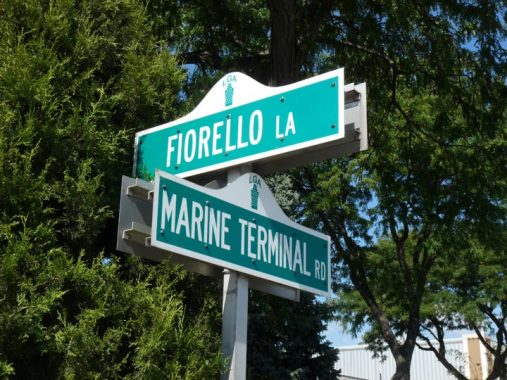
The trick, for a pedestrian, is getting there. Marine Terminal Road issues east from Ditmars Boulevard just north of Grand Central Parkway, which forms the southern edge of the airport. Kennedy Airport is much larger than LGA and has many more named roads, while LGA has just a few: Marine Terminal Road, Bowery Bay Road, and Fiorello Lane. However, these roads are far from lanes, and are dominated by rushing traffic and angry, horn-honking cabbies. Sidewalks are narrow, and while there are signs for bike lanes, I didn’t see any evidence of them.
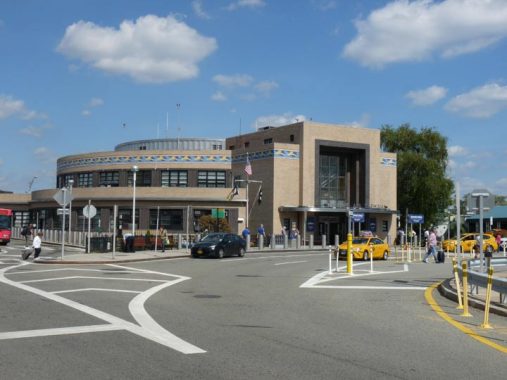
The Marine Air Terminal itself is unmistakable, at the end of Marine Terminal Road which loops around it, surrounded by large lots given over to parking and rental cars.
The MAT was constructed in 1939, when finishing touches were being applied to LGA, and opened in 1940. It was originally called the Overseas Terminal. While there are still remaining structures from LGA’s early days still standing, most notably the American Airlines building, this is the only active terminal from the 1939 era still in everyday use.
The MAT was designed by William Delano of the architectural firm Delano and Aldrich, a distant cousin of President Franklin Delano Roosevelt. The building is made up of a central, two-story central core with two symmetrical one-story wings. It was designated as a national Landmark in 1997 and underwent a $7M renovation in 2004; I first saw it a short time after that.
The terminal borders on the East River inlet south of Rikers Island, Bowery Bay, and was built to handle large seaplanes, known as “flying boats.” This explains the terra cotta flying fish ringing the exterior rotunda, and the more realistic flying fish depiction on the adjoining administration building.
The seaplane passenger market sharply declined after World War II. The MAT closed to passenger traffic during the 1950s, falling into disrepair. The magnificent James Brooks mural, Flight, was covered over but thankfully not destroyed as the Diego Rivera murals were at Rockefeller Center. In both cases the murals were covered up because of perceived socialist themes; these may have been more evident in Rivera’s work, but seem tenuous with Flight, which was uncovered in 1980. Today, JetBlue flights are accessed from the MAT.
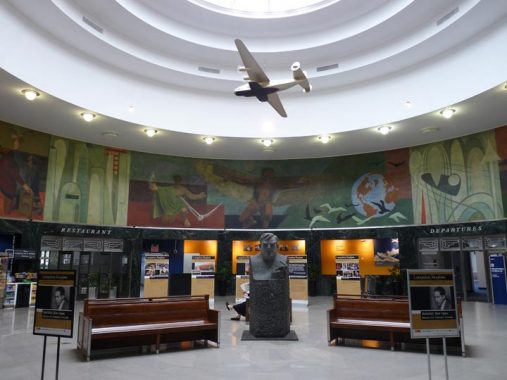
Walking through the stylized metal doors, still with wrought metal Pan Am logos, you are in the rotunda and Flight is immediately in evidence, along with a large bust of Fiorello LaGuardia, who championed the airport named for him in 1939. He famously refused to land at Newark Airport, stating that he wished to touch down in New York.
James Brooks’ mural Flight was executed in 1940 and depicts Man’s attempts at flight from antiquity, beginning with the classical myth of the inventor Daedalus, who jailbroke by inventing arm wings held together by wax. He cautioned his son Icarus to not fly too high lest the sun melt the wax. Icarus ignored him and plunged to his death. Leonardo da Vinci’s aeronautical sketches are shown, as well as Orville and Wilbur Wright.
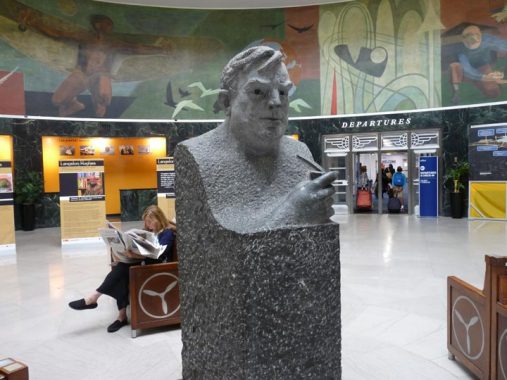
I haven’t been able to discover the sculptor who did the LaGuardia bust. Now’s your chance in Comments to fill me in.
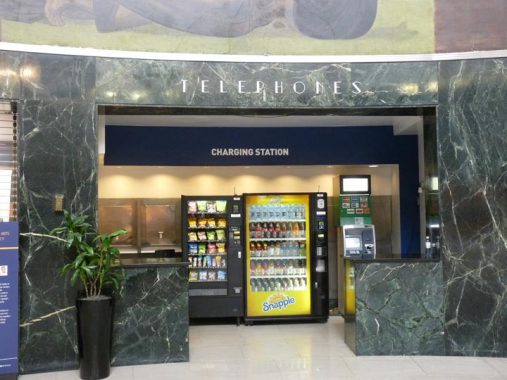
The “telephones” nook is the only one that has its original 1939 typography. There are no public phones anymore, just wifi rechargers and vending machine concessions. I was disappointed to find the restaurant closed, as snacks and drinks had been moved to the main floor. I hope the cafeteria hasn’t been permanently shut down.
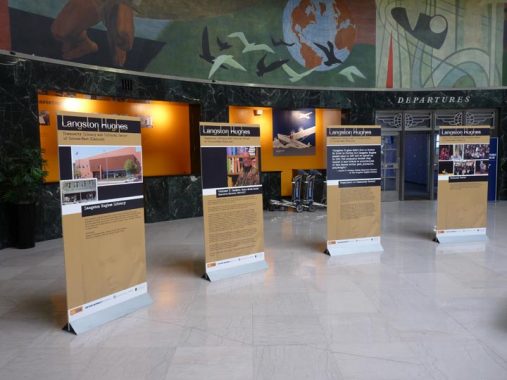
The rotunda hosts museum-like exhibitions, this one on the author and poet Langston Hughes (1902-1967). Unfortunately no one seemed to be perusing it.
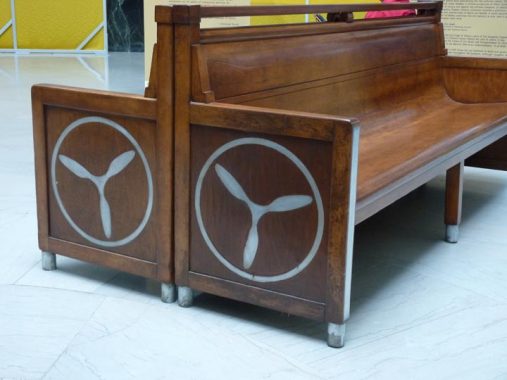
The benches are originals, or at least faithful reproductions. Note the propeller motif. The men’s room also had copies of Flight along the ceiling, with propellers on the stall doors.
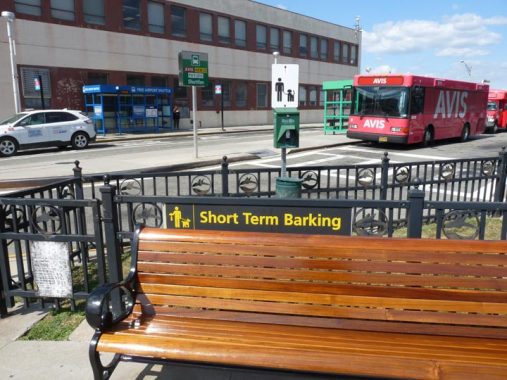
An outside “pet relief” area has a little fun with the terminology.

The LGA service roads used to be dominated by T-shaped lampposts. This twin version is the only remaining example near the MAT.
For even more restored classic airport goodness, visit the Ryan Visitors Center at Floyd Bennett Field in Marine Park, Brooklyn, from the same era.
Check out the ForgottenBook, take a look at the gift shop, and as always, “comment…as you see fit.”
9/26/19

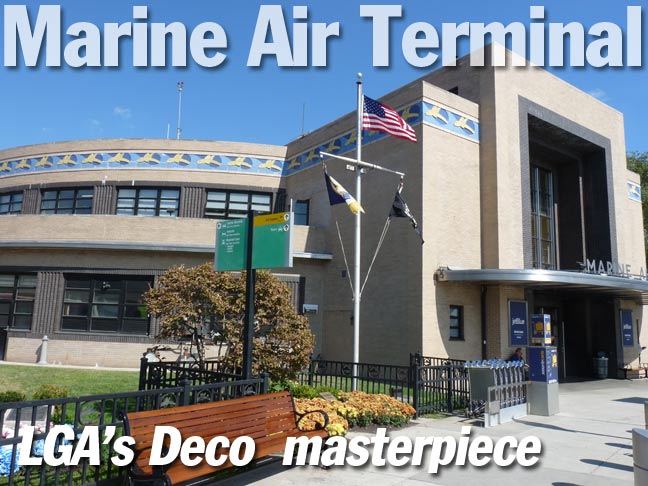
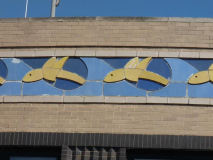
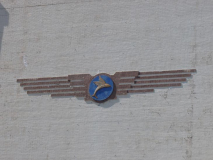
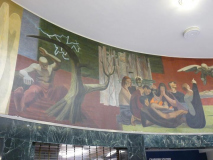
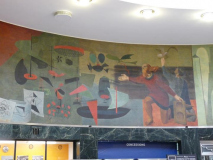
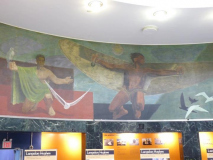
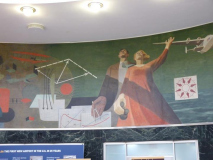
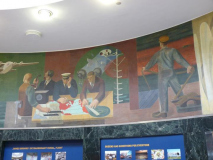
15 comments
Perfect musical accompaniment:
https://www.bing.com/search?q=come+fly+with+me+frank+sinatra&form=PRUSEN&mkt=en-us&httpsmsn=1&refig=8e21a8174efb4be58c1a381683549a3e&sp=5&qs=AS&pq=%22come+fly+with+&sk=PRES1EP1LS1AS2&sc=8-15&cvid=8e21a8174efb4be58c1a381
Perfect musical accompaniment!!!
I think the sculptor of the bust was Luis A. Sanguino.
I found this NYT article https://www.nytimes.com/1964/12/03/archives/la-guardia-bust-unveiled-at-airport.html and this article says it was moved to MAT from CTB http://www.aircargonews.com/0115/150116/Drinking-LaGuardia.html.
Back in the 1960’s and into the 1970’s the Marine Air Terminal housed the Eastern Airlines shuttle flights to Washington and Boston. These were airline flights run in the same manner as commuter trains: there was no advance booking, you just walked onto the next hourly flight paid your fare onboard to the flight attendant, or stewardess as they were known at the time. As long as you arrived at the gate by a stated deadline (10 minutes prior to departure, I believe) you were guaranteed a seat. Eastern kept a spare aircraft near the terminal and if the first one filled up they would bring out the spare one to accommodate everyone. There were occasions on which a flyer would be the *only* passenger on the spare aircraft.
Delta and American airlines still operates hourly shuttle flights, now serving Chicago in addition to Washington and Boston. They use other terminals rather than the Marine Air Terminal. Because federal law requires advance ticketing passengers buy the tickets from kiosks in the terminal rather than onboard. It’s still a very quick process, especially as there are dedicated lanes for security screening, I believe the deadline for arriving at the airport is 20 minutes before departure rather than the former 10 minutes. One big change, however, is that there are no longer any spare aircraft. If the next flight is full you have to wait an hour.
Peter: that’s not quite accurate – the Marine Air Terminal (today’s Terminal A) was never home to the Eastern Air-Shuttle. With the advent of longer-range land-based airliners, the subsequent post-war disuse of flying boats, and the moving of international traffic to the newly-opened Idlewild, the Marine Air Terminal became a much quieter place after WW2, and was actually primarily used by general aviation and some small air taxi services.
When Eastern started its Air-Shuttle service (modeled on Varig’s “Ponte Aerea” service between Rio and Sao Paolo, by the way – Eastern didn’t invent the idea) in the early 1960s, they did indeed set up shop the way you describe, with onboard ticketing, guaranteed backup sections to any one at the gate at departure time, et cetera. However, they set up the terminal at the east end of the airport in their hangar – I believe it was Hangar 8 – with a cordoned-off interior section and direct pedestrian access to the ramp outside, where the planes and their backup sections were parked. (The Air-Shuttle fleet was all one class of service and completely separated from the main fleet, by the way.) Eastern didn’t put the shuttle in the old “Landplane Terminal” or its 1964 replacement, as they felt that the Air-Shuttle needed its own facility and didn’t want the rushing shuttle passengers to mingle with the more leisurely pace of the mainline flights.
The Air-Shuttle became extremely popular, as the northeast corridor’s railroads were in disarray at the time. In fact, the shuttle was so popular that several things happened: (1) Eastern built its own stand-alone purpose-built Air-Shuttle Terminal in 1981 at the east end of the airport, adjacent to its old hangar; and (2) competition emerged, first in the form of New York Air and later in the form of the Pan Am Shuttle. When the new purpose-built Air-Shuttle Terminal was opened, the old Air-Shuttle Terminal became the short-lived “Commuter Terminal”, home to the likes of Provincetown-Boston Airlines (PBA) and Command.
When Pan Am wanted to start its own shuttle to compete, there was no room at either the old Commuter Terminal (i.e., the hangar) or in the “Main Terminal” (today’s Central Terminal, or Terminal B). They also wanted a competitive selling point vis-a-vis Eastern’s shuttle, so they chose to move into the Marine Air Terminal. It had the cachet of having hosted their flying boats, it was architecturally distinctive, and it was an exit closer to Manhattan for taxicabs – a “win-win-win”. What Pan Am did was add on the concourse extension with 6 jet gates to the east side of the Marine Air Terminal, with the small operators still using the older main part of the facility. Essentially, this is the facility you see today.
Pan Am ceased flying in 1991, and their shuttle operation was sold off in bankruptcy and became the Delta Shuttle. The Marine Air Terminal is served today by jetBlue, and Eastern was never a tenant, as far as I know.
On the east end of the airport, in the mid-1980s, Eastern wanted to leave the increasingly cramped and outmoded Main Terminal (like its rival Delta had done) and thought the best plan was to greatly expand their Air-Shuttle terminal; they thus planned a massive expansion. However, Delta had already left the Main Terminal and opened their own new “Delta Flight Center” (today’s Terminal D) in 1983 to the east of the shuttle terminal, thus closing off that direction for expansion. So Eastern planned to double-deck and expand the Air-Shuttle terminal to the west, with an additional large concourse and more modern facilities, to create the new “East End Terminal” (today’s Terminal C). This necessitated the demolition of their hangar (thus closing the “Commuter Terminal”/original Air-Shuttle Terminal). As all this planning and work was going on, Eastern became part of Frank Lorenzo’s Texas Air empire, and by the time the new Terminal C was ready to open, it was going to belong to Continental (another Texas Air holding). However, Continental felt they didn’t need such a large LaGuardia presence, as they had just opened a new mega-hub at Newark Liberty’s Terminal C (another Texas Air creation, as the original tenant of the new Terminal C at EWR was to be PeoplExpress, which Texas Air also swallowed into Continental). So the LGA Terminal C became US Airways’ baby, and hosted the US Airways Shuttle (nee Trump Shuttle, nee Eastern Air-Shuttle) for many years, as Texas Air had sold the now-bankrupt Eastern’s pieces off, and the shuttle went to Trump first and then to US Airways.
Recently, when American and US Airways merged, the US Airways Shuttle became the American Shuttle, and moved to Terminal B when American consolidated all its operations there. Delta also expanded greatly at LGA, and took over Terminal C (and in fact linked it with an airside corridor with its Terminal D). They moved their Delta Shuttle over from the Marine Air Terminal at this point, thus allowing jetBlue (and, for a time. Alaska) to have exclusive use of the Marine Air Terminal nowadays.
The resurgence of rail travel for the short shuttle flights has changed the game, and – as you mention – they are no longer a “show-up-and-go” operation. This is why they no longer really need their own facilities. In fact, Amtrak now carries more riders between New York City and Washington than the air shuttles do, and most recently both the “American Shuttle” and “Delta Shuttle” have added Chicago as a “shuttle” service. Not likely that Acela Express service will get to Chicago any time soon!
Meanwhile, as many here likely know, the old Terminal B is being completely replaced, and Delta has also committed to replacing Terminals C and D with a new (and larger) Terminal C. The new Terminals B and C will be connected both landside and airside, and will also have AirTrain LGA service over to the Willets Point LIRR/7 subway train station, for regional rail connections to both Grand Central and Penn (once the LIRR’s East Side Access opens) and for subway service along the Flushing Line.
The Marine Air Terminal/Terminal A will remain as the only “original” LGA terminal, albeit with its 1980s appendage. It will also be the only one without AirTrain LGA service – perhaps jetBlue will revive the ferry service at the rear that connected the MAT to Manhattan in the later 1980s-1990s?
Thanks.
The most interesting, accurate, and concise historical information I’ve ever read ! Thank you
I had the opportunity Spring 2019 to fly out of LaGuardia on Jet Blue. It was a surprise to see that Jet Blue flights were moved to MAT! Loved the Flight Mural and the Art Deco style of MAT. Sad that there was no longer a place to sit and eat. Hopeful it will return someday.
Mayor LaGuardia also objected to landing at Floyd Bennett Field as he felt the trip from Brooklyn into the city was too long!
For travelling the Q47 MTA bus terminates at the MAT. It runs from Atlas Park mall at Cooper & 80th St (Glendale) , northward to the airport. .A major intermediate stop is at the former Victor Moore Arcade at Broadway & Roosevelt Avenue, Jackson Heights which also serves E, F, R, M and 7 trains and other bus routes. The Q70 bus also runs from here to LaGuardia, but not the MAT.
“Victor Moore Arcade at Broadway & Roosevelt Avenue, Jackson Heights”
Where Hitchcock shot “The Wrong Man” on location, starring Henry Fonda.
You need to know that Jet Blue has as it’s primary shareholder / investor, the Evil George Soros!
Don’t believe me? Google it!
Which is why I refuse to give my hard-earned money to George Soros!!
The long history of the terminals above was thorough and interesting. My only add is that Eastern Airlines at the east end of LGA used to use 4 engine propeller Constellation planes for the shuttle for many years.
But wait, there’s more:
https://en.wikipedia.org/wiki/Eastern_Air_Lines_Shuttle
I love that black marble they used. Class.